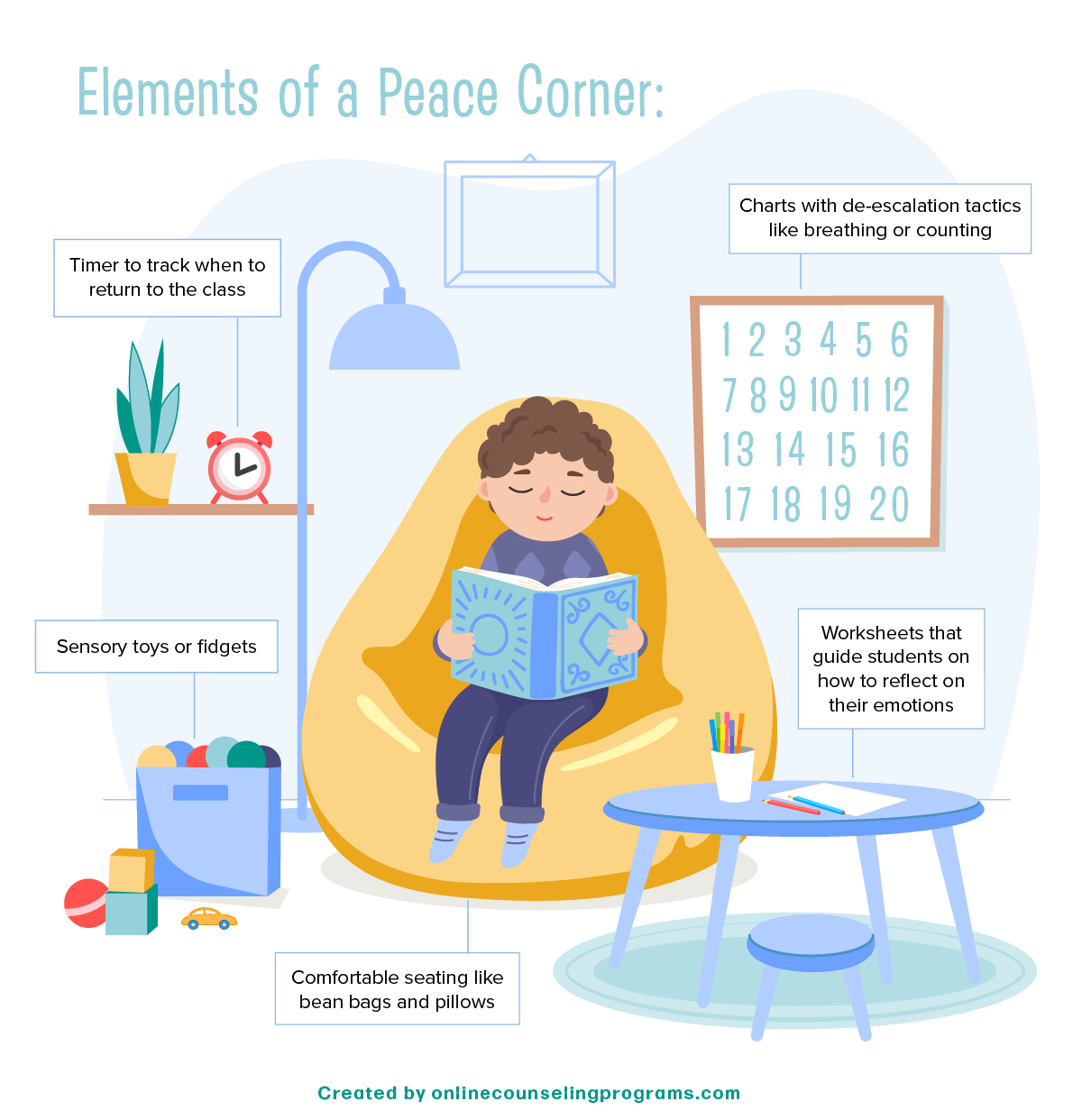Addressing Students’ Triggers: Tips for Trauma-Informed Classroom Design

When many adults hear the word trauma, their minds can go to the most extreme situations—fleeing persecution in a dangerous country or being trafficked across borders. While those situations can undoubtedly be harrowing, trauma takes many forms and is actually much more common than many people think. According to the Substance Abuse and Mental Health Services Administration, more than two-thirds of children reported experiencing at least one trauma by the age of 16.
“We don’t necessarily know which students in our classrooms and our schools have experienced trauma and which of those students are then also affected by that to the extent that it impacts their experience in school,” said Brian Cavanaugh, EdD, assistant professor of special education at University of Maine at Farmington.
Some of the causes of childhood trauma that SAMSHA identifies include:
- Psychological, physical or sexual abuse.
- Witnessing or experiencing community, school or domestic violence.
- Serious accidents or life-threatening illness.
- Sudden or violent loss of a loved one.
- Military-related family stressors, such as deployment or parental loss.
- National disasters or terrorism.
- Refugee or war experiences.
The American Psychological Association points out that although reactions to traumatic events vary among children and adolescents, temporary behavioral changes can be expected in the aftermath as children attempt to cope.
Reactions to a trauma can include:
- Development of new fears
- Separation anxiety
- Sleep disturbance
- Sadness
- Loss of interest in normal activities
- Reduced concentration
- Decline in schoolwork
- Anger
- Somatic complaints
- Irritability
Most children will return to baseline functioning, the APA reports. But some, including those who experience repeated trauma or don’t receive necessary treatment, can develop persistent reactions that affect their daily lives, called child traumatic stress. National Child Traumatic Stress Network reports that this form of stress can negatively affect a child’s physical health, their ability to form relationships, their ability to emotionally self-regulate and their development, leading to academic difficulties and behavioral problems in school. These children who experience traumatic events may constantly operate in a survival mode mindset (PDF, 3.5 MB), the National Council of Juvenile and Family Court Judges explains. Reminders of those traumas, often called triggers, can set off emotional responses for years to come.
“When you have environments that are inconsistent, that may be less safe, whether it’s emotionally or physically, that can certainly contribute to kind of triggering some of the challenges that somebody who’s been traumatized might experience,” Cavanaugh said.
According to NCJFCJ, triggers in the classroom can include:
- Yelling or fighting
- People who look similar to a person involved in the traumatic event
- Anniversaries
- Smells or sounds related to the event
- Physical touch
- Isolation
Mitigating Triggers Through Classroom Design
For people who frequently work with children, like school counselors, educators and other school staff, mitigating the effects of trauma requires being mindful about the role that environment can play.
“You might not always know what those triggers are, so I emphasize that educators should design environments where you can avoid those triggering situations,” Cavanaugh said.
Cavanaugh says that a trauma-informed classroom maximizes design to ensure:

Predictability

Safety

Positivity

Consistency
How does this translate into actual design ideas?
Ileen Henderson was the National Director of the Bright Spaces program for the Bright Horizons Foundation for Children, a nonprofit dedicated to improving the lives of children and families in crisis. Bright Spaces are safe spaces in homeless shelters, domestic violence shelters and other agencies created for children affected by trauma to grow and heal.
In an article for the early childhood magazine Exchange, Henderson says school staff who consider designing a trauma-informed classroom should first ask themselves a number of questions about what made them feel safe as children (PDF, 1.1 MB):
- Does the space feel uplifting and have color to enliven but also warmth to soothe?
- Are there places to sit near others and space to be apart?
- Are there toys that are familiar and those that will challenge without frustrating?
Answering those questions can help school staff figure out what types of design elements to incorporate in classrooms and other educational spaces. Henderson provides some recommendations in the article:
- Lower the lights and soften loud noises.
- Limit bright colors.
- Minimize visual messages on the walls.
- Limit the number of materials on shelves.
- Provide defined spaces for children to work independently.
- Offer a soft space for children to relax.
- Use culturally sensitive décor.
“Cool down” or “peace corners” are also a design element that educators may want to incorporate into their classrooms. Edutopia recently highlighted how Fall-Hill Elementary School in Nashville uses peace corners to help students manage their emotions when they begin to become stressed, frustrated or angry.
Features of the peace corner include:
- Designated area away from the rest of the class.
- Comfortable seating like bean bags and pillows.
- Sensory toys or fidgets.
- Timer to track when to return to the class.
- Worksheets that guide students on how to reflect on their emotions.
- Charts with de-escalation tactics like breathing or counting.

The School Counselor’s Role in Providing Trauma-Informed Care
Design is just one way that schools can respond to the needs of students who experience trauma.
As NCTSN explains, a trauma-informed school system (PDF, 987 KB) does the following:
- Recognizes and responds to the effects of trauma.
- Infuses awareness and knowledge into the culture and policies of the school.
- Works with the appropriate stakeholders to promote recovery and resilience.
- Promotes a welcoming climate and creates an environment that avoids re-traumatization.
- Focuses on building relationships between students and school staff.
- Uses a balanced restorative justice approach to conflict.
School counselors can improve the overall school system by also employing trauma-informed practice. This includes identifying students who may show signs of trauma; educating staff, families and students about the effects of trauma; and implementing positive behavioral interventions that improve social and emotional learning, as described in the position statement of the American School Counselor Association.
“For some kids that have experienced trauma, that might manifest itself through behavior,” Cavanaugh said. “To the extent that we can support more positive, more effective behaviors in school, that’s really critical.”
However, in an article for the Child Mind Institute, psychiatrist Nancy Rappaport, MD, explains that it’s also important to recognize that children and adolescents who experienced trauma may have difficulty trusting adults, particularly if other adults contributed to that traumatic event in some form.
“These kids don’t have the context to ask for help,” says Rappaport, who is also a school consultant and associate professor of psychiatry at Harvard Medical School. “They don’t have a model for an adult recognizing their needs and giving them what they need.”
Design is just one way that schools can respond to the needs of students who experience trauma.
In those situations, school counselors and other school staff should cultivate relationships by offering support in an affirming way. Rappaport says to first work with students on acknowledging and identifying emotions. Understanding that a school counselor or other staff member “gets it” will enable students to more appropriately express their emotions.
“The more you know about the student the better, which again goes back to those relationships,” Cavanaugh added, “If you have that relationship with the family, with the community, with the student, you’re more likely to understand what some of those triggers may be.”
Are you interested in working with student populations? Learn how to become a school counselor.
The article is for informational purposes. If a child is experiencing signs of trauma, please consult a medical professional or mental health practitioner.

